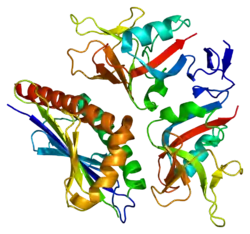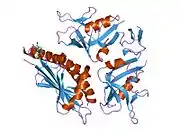ULBP3
UL16 binding protein 3 (ULBP3) is a cell surface glycoprotein encoded by ULBP3 gene located on the chromosome 6.[3][4] ULBP3 is related to MHC class I molecules, but its gene maps outside the MHC locus.[3][4] The domain structure of ULBP3 differs significantly from those of conventional MHC class I molecules. It does not contain the α3 domain and the transmembrane segment. ULBP3 is thus composed of only the α1α2 domain which is linked to the cell membrane by the GPI anchor.[3][4] It functions as a stress-induced ligand for NKG2D receptor.[3]
References
- GRCh38: Ensembl release 89: ENSG00000131019 - Ensembl, May 2017
- "Human PubMed Reference:". National Center for Biotechnology Information, U.S. National Library of Medicine.
- Cosman D, Müllberg J, Sutherland CL, Chin W, Armitage R, Fanslow W, Kubin M, Chalupny NJ (Feb 2001). "ULBPs, novel MHC class I-related molecules, bind to CMV glycoprotein UL16 and stimulate NK cytotoxicity through the NKG2D receptor". Immunity. 14 (2): 123–33. doi:10.1016/S1074-7613(01)00095-4. PMID 11239445.
- Radosavljevic M, Cuillerier B, Wilson MJ, Clément O, Wicker S, Gilfillan S, Beck S, Trowsdale J, Bahram S (Jan 2002). "A cluster of ten novel MHC class I related genes on human chromosome 6q24.2-q25.3". Genomics. 79 (1): 114–23. doi:10.1006/geno.2001.6673. PMID 11827464.
Further reading
- Cerwenka A, Lanier LL (May 2003). "NKG2D ligands: unconventional MHC class I-like molecules exploited by viruses and cancer". Tissue Antigens. 61 (5): 335–43. doi:10.1034/j.1399-0039.2003.00070.x. PMID 12753652.
- Eleme K, Taner SB, Onfelt B, Collinson LM, McCann FE, Chalupny NJ, Cosman D, Hopkins C, Magee AI, Davis DM (Apr 2004). "Cell surface organization of stress-inducible proteins ULBP and MICA that stimulate human NK cells and T cells via NKG2D". The Journal of Experimental Medicine. 199 (7): 1005–10. doi:10.1084/jem.20032194. PMC 2211882. PMID 15051759.
- Sutherland CL, Chalupny NJ, Schooley K, VandenBos T, Kubin M, Cosman D (Jan 2002). "UL16-binding proteins, novel MHC class I-related proteins, bind to NKG2D and activate multiple signaling pathways in primary NK cells". Journal of Immunology. 168 (2): 671–9. doi:10.4049/jimmunol.168.2.671. PMID 11777960.
- Radaev S, Rostro B, Brooks AG, Colonna M, Sun PD (Dec 2001). "Conformational plasticity revealed by the cocrystal structure of NKG2D and its class I MHC-like ligand ULBP3". Immunity. 15 (6): 1039–49. doi:10.1016/S1074-7613(01)00241-2. PMID 11754823.
- Steinle A, Li P, Morris DL, Groh V, Lanier LL, Strong RK, Spies T (2001). "Interactions of human NKG2D with its ligands MICA, MICB, and homologs of the mouse RAE-1 protein family". Immunogenetics. 53 (4): 279–87. doi:10.1007/s002510100325. PMID 11491531. S2CID 33695596.
This article is issued from Wikipedia. The text is licensed under Creative Commons - Attribution - Sharealike. Additional terms may apply for the media files.



